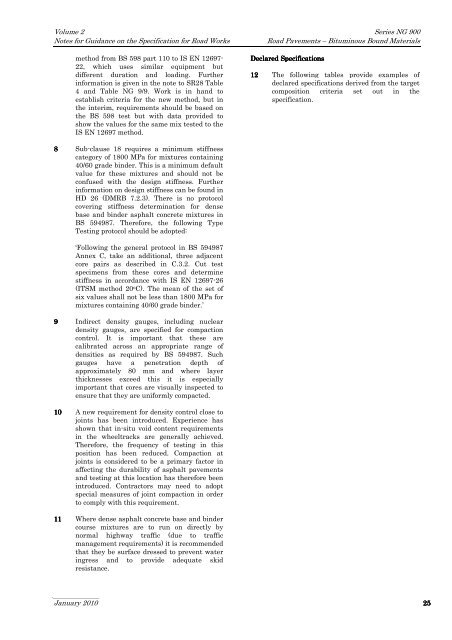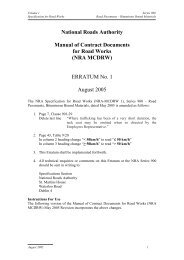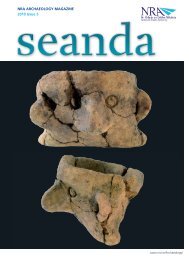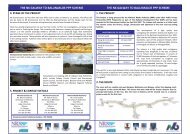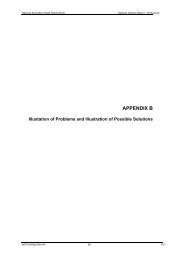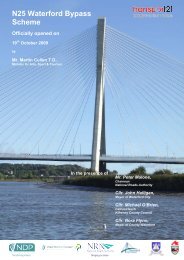ROAD PAVEMENTS – BITUMINOUS BOUND MATERIALS Contents
ROAD PAVEMENTS – BITUMINOUS BOUND MATERIALS Contents
ROAD PAVEMENTS – BITUMINOUS BOUND MATERIALS Contents
You also want an ePaper? Increase the reach of your titles
YUMPU automatically turns print PDFs into web optimized ePapers that Google loves.
Volume 2 Series NG 900<br />
Notes for Guidance on the Specification for Road Works Road Pavements <strong>–</strong> Bituminous Bound Materials<br />
method from BS 598 part 110 to IS EN 12697-<br />
22, which uses similar equipment but<br />
different duration and loading. Further<br />
information is given in the note to SR28 Table<br />
4 and Table NG 9/9. Work is in hand to<br />
establish criteria for the new method, but in<br />
the interim, requirements should be based on<br />
the BS 598 test but with data provided to<br />
show the values for the same mix tested to the<br />
IS EN 12697 method.<br />
8 Sub-clause 18 requires a minimum stiffness<br />
category of 1800 MPa for mixtures containing<br />
40/60 grade binder. This is a minimum default<br />
value for these mixtures and should not be<br />
confused with the design stiffness. Further<br />
information on design stiffness can be found in<br />
HD 26 (DMRB 7.2.3). There is no protocol<br />
covering stiffness determination for dense<br />
base and binder asphalt concrete mixtures in<br />
BS 594987. Therefore, the following Type<br />
Testing protocol should be adopted:<br />
‘Following the general protocol in BS 594987<br />
Annex C, take an additional, three adjacent<br />
core pairs as described in C.3.2. Cut test<br />
specimens from these cores and determine<br />
stiffness in accordance with IS EN 12697-26<br />
(ITSM method 20 o C). The mean of the set of<br />
six values shall not be less than 1800 MPa for<br />
mixtures containing 40/60 grade binder.’<br />
9 Indirect density gauges, including nuclear<br />
density gauges, are specified for compaction<br />
control. It is important that these are<br />
calibrated across an appropriate range of<br />
densities as required by BS 594987. Such<br />
gauges have a penetration depth of<br />
approximately 80 mm and where layer<br />
thicknesses exceed this it is especially<br />
important that cores are visually inspected to<br />
ensure that they are uniformly compacted.<br />
10 A new requirement for density control close to<br />
joints has been introduced. Experience has<br />
shown that in-situ void content requirements<br />
in the wheeltracks are generally achieved.<br />
Therefore, the frequency of testing in this<br />
position has been reduced. Compaction at<br />
joints is considered to be a primary factor in<br />
affecting the durability of asphalt pavements<br />
and testing at this location has therefore been<br />
introduced. Contractors may need to adopt<br />
special measures of joint compaction in order<br />
to comply with this requirement.<br />
11 Where dense asphalt concrete base and binder<br />
course mixtures are to run on directly by<br />
normal highway traffic (due to traffic<br />
management requirements) it is recommended<br />
that they be surface dressed to prevent water<br />
ingress and to provide adequate skid<br />
resistance.<br />
Declared Declared Specifications<br />
Specifications<br />
Specifications<br />
12 The following tables provide examples of<br />
declared specifications derived from the target<br />
composition<br />
specification.<br />
criteria set out in the<br />
January 2010 25 25


